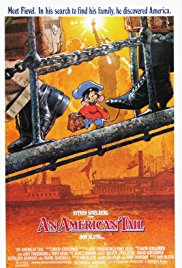Stories are essential tools for verbal development, social-emotional learning, and character education. Intentional parents can use family movies as a basis for storytelling.
Repeat the story of the movie at bedtime, on a rainy day, or at any quiet time. Let your child correct you if you make a mistake and, better yet, encourage your child to tell you the story. Both of you can invent new adventures for Fievel and his friends. Your child’s imaginative and verbal capacities will be enhanced if you invent new characters and create situations that are not in the movie. To learn more about enhancing growth and development through stories told to children, go to How to Tell Bedtime Stories . . . Any Time.
Here is a bedtime story developing a theme in “An American Tail”.
Back when the United States was a young country and was just filling up with people, big sailing ships brought millions of immigrants from Europe. Many of them got off the ships at New York City. Mice were able to stow away on the ships and come to New York as well. Two of these mice were, Billy and Milly. They were young and had actually been born on the ship as it rolled in the waves.
Billy’s fur was so dark, it was almost black. He was a roly poly little mouse who always ate too much. Milly was a brown mouse and very slim. Billy and Milly were best friends. They loved to explore their new home town to find fun things to do and new foods to try.
One day, when they were having lunch from a turned over garbage can near a big open air market, Billy heard a tiny voice crying. It seemed to be coming from an alley to their right. Billy and Milly peeked into the alley and saw a little grey mouse, wiping away tears. Billy asked his name and what was wrong.
The grey little mouse said, “My name is William and my family and I just arrived from England. We were looking for food in the market when I got lost. And now I can’t find them!” William began to cry again.
Billy remembered how scared he had been when he first came to America, and couldn’t imagine how scared he would have been if he had gotten lost! Milly gave William a hug. Then Billy said, “Come with us. We’ll help you find your mom and dad!”
William smiled bravely and made one more effort to stop sobbing. Then the three mice started scurrying through the market, hiding from the people but making little squeaks that only mice could understand. They were calling for William’s parents. After a while, it began to get dark and William became sad again. He started to cry very quietly, saying, “I’m never going to find my mum and dad! I’m never, never, ever going to find my family again!”
Billy gave William a hug and said, “Don’t give up! If we give up, we’ll never find them.” But Milly and Billy were worried, too. They ran about faster and faster, calling out for William’s parents.
(If your child isn’t sleepy, pause here and start a conversation by
asking what he or she thinks is going to happen next.)
All of a sudden, they heard two voices with British accents calling “William! Willy! William . . . where are you?”
Billy, Milly and William ran toward the voices, and sure enough, it was William’s mom and dad. As soon as they saw William, they scooped him up and gave him lots of hugs and kisses. “We were looking all over for you!” they said.
Then they saw Billy and Milly. “And who are these new friends?”
“I’m Billy,” said the plump black mouse.
“I’m Milly,” said the slim brown mouse.
“They’re my new friends,” said the little grey mouse.
William’s dad laughed, “Well, look at that! Billy, Milly and Willy! You’ll be friends forever!” Then they all laughed.
William’s mom gave him a big kiss and said, “Oh, William, I was worried we’d never find you!”
William grinned hugged her tightly and said, “So was I, but we never gave up, did we?”
The End.


